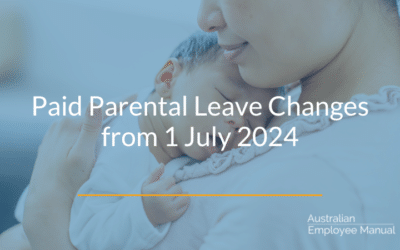In the past month, two major pieces of legislation were enacted that impact how workplaces prevent and respond to sexual harassment.
The Anti-Discrimination and Human Rights Legislation Amendment (Respect at Work) Act and the Fair Work Legislation Amendment (Secure Jobs, Better Pay) Act contain provisions that all businesses, no matter their size, need to be aware of.
These changes came from recommendations from the Sex Discrimination Commissioner’s Respect@Work Report. This report was released on 5 March 2020 based on the findings of the National Inquiry into Sexual Harassment in Australian Workplaces.
The National Inquiry found that 39% of women and 26% of men had experienced sexual harassment in the workplace in the previous 5 years.
In addition to gender, certain workers were more likely to be harassed than others, including young workers, LGBTIQ workers, Aboriginal and Torres Strait Island workers, workers with a disability and workers from culturally and linguistically diverse backgrounds.
The Respect@Work Report found that existing legal and regulatory frameworks were complex, difficult to navigate, focussed on reacting to complaints rather than preventing complaints and placed a significant burden on individuals who experience sexual harassment to make a complaint.
The legislative changes that were recently passed, are designed to create safer, more respectful, and more equitable workplaces.
Fair Work Legislation Amendment (Secure Jobs, Better Pay) Act
Under the changes, sexual harassment in the workplace is now prohibited. This prohibition covers all “workers”, including employees, contractors, subcontractors, outworkers, apprentices, trainees, students, volunteers, and prospective workers.
One of the most significant changes involves the prohibition extending to third parties in a workplace, which includes clients and customers. This means businesses must take action to prevent and respond to clients and customers sexually harassing employees in the workplace.
The legislation also expands how the Fair Work Commission and Courts can respond to and handle sexual harassment matters.
The Fair Work Commission can now mediate or arbitrate sexual harassment disputes and order compensation. In addition, the matter can also proceed to the Federal Court or the Federal Circuit and Family Court of Australia if the matter is unresolved at the Fair Work Commission.
Also, the Fair Work Ombudsman can now investigate and bring civil penalty proceedings against employers or individuals who contravene the prohibition of sexual harassment in the workplace.
These new resolution rights exist in addition to the worker or their union being able to take the matter to the Australian Human Rights Commission. However, workers or their unions can only choose one path for resolution (e.g., Fair Work or the Australian Human Rights Commission).
One last fundamental change, employers are vicariously liable for the actions of their workers or third-party agents (i.e., customers and clients) unless they can prove they took all reasonable steps to prevent sexual harassment in their workplace.
Anti-Discrimination and Human Rights Legislation Amendment (Respect at Work) Act
The Respect at Work Act has made significant changes to how sexual harassment is to be prevented and managed.
Proactive Prevention of Discrimination & Harassment
Current measures only focus on responding to conduct that has already happened. This Act has shifted the focus by requiring employers to proactively prevent discrimination and harassment in their workplaces.
Under the Act, employers now have a positive duty to take reasonable and proportionate measures to eliminate, as far as possible, unlawful sex discrimination, sexual and sex-based harassment, hostile work environments, and victimisation.
A key thing to note is that the proactive duty also means that employers must take measures to protect their employees from being sexually harassed or harassed on the grounds of sex by third parties, such as clients and customers.
The meaning of ‘reasonable and proportionate measures’ will vary between employers depending on their circumstances and may include:
- the size, nature and circumstances of the business or undertaking,
- the duty holder’s resources, whether financial or otherwise, and
- the practicability and costs associated with the steps.
The sort of measures that businesses should consider will differ and include:
- having a strong and clear policy on discrimination and harassment and making sure it is communicated effectively in the workplace,
- ensuring there is clear, unambiguous, and visible support from senior management for the policy,
- developing a procedure to respond to internal complaints about discrimination and harassment in a fair, timely and effective way,
- treating all complaints seriously and investigating them promptly,
- ensuring all staff are aware of the organisation’s policies and procedures regarding discrimination and harassment,
- collecting and monitoring data about preventative measures, complaints and actions taken,
- providing regular training to staff to ensure they understand their workplace responsibilities and to identify and respond to incidents of sexual harassment.
The Act recognises that micro or smaller businesses may have more informal or limited measures to prevent unlawful conduct compared to larger businesses. However, smaller businesses are still required to take less costly steps, such as regularly communicating expectations to employees and referring to existing policies and procedures or other guidance material.
For example, if a business is relying on the existence of policies and procedures as a defence against vicarious liability before the Courts, these policies need to be clear, in written form, communicated to all members of the workforce and periodically reinforced.
These changes dovetail with the Fair Work Act changes relating to vicarious liability and complement existing Workplace Health and Safety requirements that all employers provide a safe working environment for their employees.
Prohibiting Hostile Workplace Environments
The Act now prohibits conduct that subjects another person to a workplace environment that is hostile, intimidating, or offensive on the grounds of sex.
The Respect@Work Report found that sexual harassment may occur where a workplace environment is sexually charged or hostile, even if the specific conduct is not directed at a particular person. In such an environment, people of one sex are made to feel uncomfortable or excluded by the workplace environment
They noted that conduct such as displaying obscene or pornographic materials, general sexual banter, innuendo, and offensive jokes may indicate the existence of a hostile work environment. These environments can increase the risk of people experiencing other forms of unlawful discrimination, such as sexual harassment.
The Act sets out the meaning of subjecting a person to a hostile workplace environment, which includes a requirement that a reasonable person, having regard to all the circumstances, would have anticipated the possibility of the conduct resulting in the workplace environment being offensive, intimidating or humiliating because of sex or related characteristics.
The circumstances that will be considered when determining whether the conduct is unlawful include:
- the seriousness of the conduct,
- whether the conduct was continuous or repetitive,
- the role, influence or authority of the person engaging in the conduct, and
- any other relevant circumstance.
It is important to note that not all these circumstances need to be met for a hostile work environment to be established.
One of the crucial things to remember is that a hostile work environment is not just created by employee to employee interactions: It also includes clients or customers interacting with employees. If you have clients or customers who regularly make derogatory remarks to employees based on their sex, this creates a hostile working environment.
Employers must take measures to protect their employees from being subject to a hostile work environment by third parties, such as clients or customers.
Other Changes
The Act provided other changes, including:
- Lowering the threshold for sex-based harassment. Previously the threshold was “unwelcome conduct of a seriously demeaning nature.” The Act removes the word “seriously” to become “unwelcome conduct of a demeaning nature.”
- Clarification that victimising conduct can form the basis of civil action for unlawful discrimination.
- Additional investigation, inquiry, and enforcement provisions for the Australian Human Rights Commission.
- Permitting of class actions by a representative body such as a union for unlawful discrimination.
- Extension of the time limit for commencing a complaint from 6 months to 24 months after the alleged unlawful conduct took place.
Commencement Dates
Because these changes are so significant, the Act has staggered commencement dates.
The provisions relating to the Human Right Commission’s new compliance powers and role do not come into power for 12 months.
This means businesses have a year to get their houses in order to implement these changes before facing potential non-compliance cases before the Australian Human Rights Commission.
Actions Businesses Should Take Now
All businesses already have obligations under Workplace Health and Safety and Anti-Discrimination legislation to ensure employees are not subjected to sexual harassment. These changes substantially expand these obligations, so all employers need to take action to ensure compliance.
- All businesses should review the sexual harassment guidance materials provided by the Australian Human Rights Commission and the Respect@Work Council through the Respect@Work website https://www.respectatwork.gov.au/
- Undertake a Risk Assessment or formal audit to understand potential exposure points and risk areas in their business.
- Businesses should review their existing policies and procedures to ensure they comply with the new guidelines and include a robust complaints/grievance handling process.
- Ensure clear policies and procedures relating to inappropriate conduct by clients or customers.
- Ensuring all Executives and Managers are briefed/trained in the changes and the role they are expected to play in modelling appropriate behaviour, intervening in issues and responding to complaints.
- Planning and delivering regular awareness training for all employees.
- Publicising their zero-tolerance policy for harassment towards employees.
We will be amending the Sexual Harassment policy and forms in our Employee Manual suite of products in the next update to our products to help subscribers meet their obligations under this new legislation.




